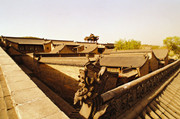Shanxi province
( www.chinadaily.com.cn )
Updated: 2012-03-14
Please put on your earphones and watch the landscape of Shanxi province. Enjoy it!
Shanxi province (Jin, in abbreviated form) lies along the middle reaches of the Yellow River, to the west of the Taihang Mountains, in central China, covering 156,000 square kilometers. It has a population of 33.55 million and includes 11 cities and 119 counties and districts. It lies in a temperate zone with a continental climate and has distinct seasons. Most of it is more than 1,000 meters above sea level, with hills covering two-thirds of the province.
The province is rich in minerals with a great variety spread across a wide area. It has 120 known minerals, 62 with proven reserves; 34 of these ranking among the top 10 in the country by reserves. It ranks first in the country in coal, coal bed methane, bauxite, coal clay, laterite, and potassium reserves and has the second largest rutile, pearlite, gallium, vermiculite and glass-oriented limestone reserves. The province has been called the “home of coal”, because of its 260 billion tons of proven reserves, or a third of the country’s total. Its coal varies but is of good quality and its coal fields are found in Datong, Ningwu, Xishan, Huoxi, Hedong and Qinshui.
History and culture
Shanxi is considered the cradle of the Chinese civilization and has a rich history and cultural heritage. One of the earliest ancestors of the Chinese, Emperor Yan (c.25th century BC), was said to have lived around Changzhi, in southeast Shanxi. Even earlier, (4,000-5,000 years ago), emperors Yao, Shun and Yu had capitals in Shanxi. The Xia Dynasty (c.21st century-16th century BC), the first slave-owning state in Chinese history, was founded in the southern part of Shanxi.
Written records show Shanxi with more than 3,000 years of history. it has 35,000 relic sites that include architecture, grottoes, houses, murals, and sculptures with distinct features, so Shanxi is said to be an “ancient Chinese culture museum”. Over 70 percent well preserved ancient architecture from before the Jin (265-420) and Song (AD 420-479) dynasties is in Shanxi province. Shanxi has 119 relics under national protection, the largest number in the country. The old town of Pingyao and the Yungang Grotto are on the world cultural heritage list.
Over a period of five centuries, during the Ming and Qing dynasties (1368-1911), Shanxi merchants left behind spiritual wealth through their thrift, diligence, discipline, integrity, and management skills.
Tourism
Along with its long history and rich cultural heritage, Shanxi’s landscape also gives visitors a lot to see with its great variety. Its unique landscape provides some spectacular natural sights.




